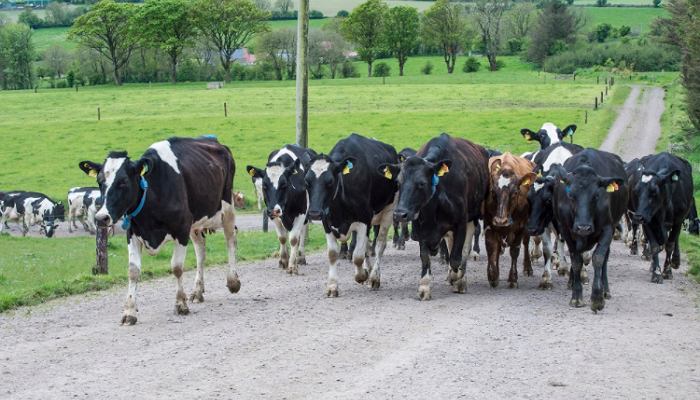17 April 2023
Strategies to reduce lameness on your farm

Lameness is a painful disease that results in suffering for dairy cows, and damages the sustainable and welfare-friendly image of Irish agriculture. Lameness also has negative financial implications due to reduced milk yield and fertility rates, and increased culling and treatment costs.
Teagasc lameness study
A study was carried out by Teagasc to determine the prevalence of dairy cow lameness during the grazing and housing periods, and to identify potential risk factors for lameness. Ninety-nine pasture-based Irish dairy farms were visited when cows were at grass (April– September 2019), and 85 of those farms were visited on a second occasion when the cows were housed (October 2019–February 2020).
At each visit, all cows in the dairy herd were mobility scored. Mobility scoring involves scoring each cow individually from zero (good mobility) to three (severely impaired mobility) as they walk. Alongside daily lameness detection, regular mobility scoring enables early detection of lameness (and therefore prompt treatment), and enables farmers to compare lameness prevalence in their herd with others and to observe how lameness prevalence is changing in their herd over time.
A questionnaire was completed with the farmer at each visit to determine lameness prevention, detection and treatment methods currently used on Irish dairy farms. Infrastructural measurements and observations were made of milking facilities, housing and cow roadways. Individual cow data (age, parity, days in milk, yield, breed, EBI) were provided by ICBF. All questionnaire, infrastructural and ICBF data were included in the risk factor analysis.
Lameness prevalence
Average lameness prevalence was 7.9% during the grazing period and 9.1% during housing (Figure 1). The number of severely lame cows observed during the grazing and housing periods was 0.7% and 0.8%, respectively. The most prevalent lesion types found in lame cows were white line disease, sole haemorrhages and overgrown claws.
Figure 1: Average lameness prevalence during the grazing (99 farms) and housing (85 farms) on Irish pasture-based dairy farms

Lameness detection and treatment
Only 1% of farmers mobility-scored their herd and over half of farmers were unfamiliar with mobility scoring. Prompt treatment is vital for lameness recovery, yet 28% of farmers usually waited more than two days to treat a lame cow once detected and 21% waited for multiple cows to become lame before treating. Less than 10% of farmers reported giving pain relief to severely lame cows and only 3% to mildly lame cows. Providing pain relief to all lame cows, alongside hoof trimming where necessary, dramatically improves the rate of recovery and improves the welfare of the animal. 12% of farmers maintain severely lame cows in a separate group near the milking parlour. Minimising walking distances for lame cows is advisable to reduce discomfort.
Lameness prevention – management and infrastructure
Cows with a negative predicted transmitting ability (PTA) for lameness (i.e. lower genetic susceptibility) had a reduced risk of lameness compared to a positive PTA. Lameness PTA can be found in the EBI health sub-index. This indicates the importance of bull selection as a long-term lameness prevention method.
Despite 44% of farmers reporting that they have digital dermatitis (Mortellaro) on their farm, only 31% of farmers regularly footbath (>12 times per year). Footbathing is a key measure in the control of digital dermatitis. Farmers should communicate with their vet to determine the best footbathing protocol.
Results showed that the presence of stones in paddock gateways and slats on roadways near the collecting yard were risk factors for lameness. Stony and uneven surfaces may damage the hoof and result in the formation of white line lesions. Gateways may be high risk areas due to crowding and pushing as cows enter or leave the paddock, resulting in cows not being able to choose their hoof placement. This study also showed that when cows had to make a sharp turn as they leave the milking parlour, lameness risk increased. This should be considered in the construction and maintenance of parlours.
Conclusion
Early detection and treatment is recommended to reduce lameness. Optimal infrastructure and management practices are also key to preventing lameness and reducing herd lameness prevalence.
This article by Natasha Browne and Muireann Conneely, Teagasc Moorepark, first appeared in the Irish Dairying – Delivering Sustainability open day book.
